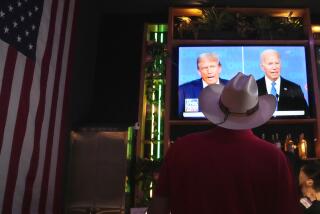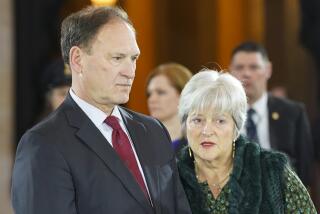Sotomayor casts herself as mechanic with a gavel
WASHINGTON — Supreme Court nominee Sonia Sotomayor maneuvered through three days of an often-antagonistic confirmation hearing by portraying herself as a legal mechanic who would stick to precedent and never “make law.” But in doing so she revealed almost nothing about the philosophy that would guide her on the high court.
It is not clear whether this play-it-safe strategy was a political calculation, perhaps dictated by the White House, or an accurate reflection of her background as a lower court judge who has not formed broader views on the law.
Either way, it seemed to have worked. By the last day of the hearing, even skeptical Republicans softened toward President Obama’s nominee.
They assured her they would not try to block her confirmation, and some conservatives said they might vote for her. A Senate vote on her nomination is expected by early August.
But some prominent legal experts on the left and the right panned her performance.
“Her mantra -- ‘I just follow the law, I just follow the law’ -- is an insult to the intelligence of the American public,” said Abigail Thernstrom, a conservative analyst at the American Enterprise Institute.
Yale Law School professor Heather Gerken said Sotomayor’s testimony “drained the life out of the law” and turned it into a “witless, mechanical exercise. . . . It’s too bad that what is perhaps the law’s most public moment gives the public so little sense of what a remarkable institution it is.”
Unlike lower courts, the Supreme Court usually hears cases only when judges are divided on the law and legal precedents. There is no mechanical right answer.
In the next year, the high court will probably decide whether the 2nd Amendment gives all Americans a “fundamental right” to have guns, even if their city or state restricts firearms. And soon after, the court will be pressed to decide whether the Constitution’s guarantee of “equal protection of the laws” forbids discrimination against gays and lesbians, including in marriage.
Sotomayor gave no hint about how she would weigh gun rights or gay rights, except to say she had not prejudged the questions.
UC Davis School of Law professor Vikram Amar said the hearing was “less than useless. If Judge Sotomayor won’t meaningfully discuss any legal topics in front of the Senate, then what’s the point of the hearings?”
The sad state of Supreme Court confirmation hearings is usually traced to the 1987 defeat of Judge Robert H. Bork, a scholarly conservative. To no avail, he tried to explain and defend his many legal writings that had condemned the Supreme Court as too liberal on abortion and civil rights.
Four years later, Clarence Thomas won a close battle in the Senate by portraying himself as a blank slate with no views on the law. He told senators he had not discussed Roe vs. Wade or formed an opinion on the controversial abortion ruling.
Ever since, Supreme Court nominees have assumed it is more dangerous to explain too much, rather than too little, when talking about what they think of the Constitution and the law.
President George W. Bush’s two court nominees -- John G. Roberts Jr. and Samuel A. Alito Jr. -- performed much like Sotomayor. They explained their rulings but refused to talk more broadly about their views of the Constitution or the law. Roberts described the job as being “like an umpire . . . calling balls and strikes.”
Their description of the job as mechanical meshed with the conservative view that courts should do less and leave the big decisions to the elected branches of government.
Liberals had hoped an Obama nominee would bring a larger vision of the Constitution and the role of the high court. That explains some of their disappointment.
“Sotomayor stayed to the Roberts script,” said Erwin Chemerinsky, dean of UC Irvine School of Law. “She described judging as mechanical. I understand why this is the script now, but I am troubled that it paints such a disingenuous and false impression of judging.”
Even those who were disappointed said it was not fair to blame her.
“I do think she was boxed in,” said Gerken, a former clerk to Justice David H. Souter, whose seat Sotomayor would fill. “Virtually any answer other than the answer she gave ends up evoking cries of judicial activism. The result, unfortunately, is that judges are portrayed as automatons or activists, when most are neither.”
Sotomayor went into the hearing with solid support from Democrats, but she faced criticism from conservatives on several fronts. They said that her “wise Latina” speech and Obama’s comments favoring judges with “empathy” suggested she would lean in favor of racial and ethnic minorities. Others repeated anonymous complaints from a few New York lawyers who called her a bully on the bench.
Sotomayor effectively put the charges to rest. She retreated from the “wise Latina” speech and said she did not mean to suggest that her background gave her superior insight. She disagreed with Obama and said a judge’s heart could not decide cases. And she displayed a steady demeanor in answering sharp questions.
“I think Judge Sotomayor performed very well,” said Maria Blanco, executive director of the Earl Warren Institute at UC Berkeley. “In the face of comments that she was hot-tempered and adversarial, she answered those charges by exhibiting a calm, thoughtful and unflappable manner. And she came across as having an extremely sharp legal mind.”
The final day of the hearing saw a role reversal of sorts, as GOP senators asked the Bronx-born Sotomayor to identify with gun owners in Oklahoma and Wyoming.
Earlier, Sotomayor had been put on notice that she should not rely on her personal experiences or empathy in deciding cases. But Republican senators said she needed to put herself in the shoes of gun owners when she decided whether the 2nd Amendment freed them from state and local gun restrictions.
“Hopefully you’ll talk to your godchild, who’s an NRA member,” said Sen. Lindsey Graham (R-S.C.).
Unflappable to the end, Sotomayor refused to be swayed. “I can assure your constituents,” she said, “that I have a completely open mind on this question.”
--
More to Read
Get the L.A. Times Politics newsletter
Deeply reported insights into legislation, politics and policy from Sacramento, Washington and beyond. In your inbox three times per week.
You may occasionally receive promotional content from the Los Angeles Times.











